Note: for the full suite of measurements from the SoundStage! Audio-Electronics Lab, click here.
 I enjoy integrated amplifiers and I love reviewing them. Something excites me about a product that combines almost everything an audio system requires, save speakers, into one cost-effective unit. Over the years, before making the jump to separates, I owned several high-quality integrateds. I still have a special place in my heart for integrated amps, like the Hegel H120 integrated amplifier-DAC I have in my second audio system, the one I use in my family room when I’m watching television or listening to music while I work or do things around the house.
I enjoy integrated amplifiers and I love reviewing them. Something excites me about a product that combines almost everything an audio system requires, save speakers, into one cost-effective unit. Over the years, before making the jump to separates, I owned several high-quality integrateds. I still have a special place in my heart for integrated amps, like the Hegel H120 integrated amplifier-DAC I have in my second audio system, the one I use in my family room when I’m watching television or listening to music while I work or do things around the house.
I’ve reviewed many integrated amplifiers over the past few years, from the all-analog and beautifully crafted Yamaha A-S3200 to the entry level yet ridiculously full-featured, DSP-enabled miniDSP SHD Power—and many in between. While integrateds like the Arcam SA30 and NAD Masters M33 have deservedly received SoundStage! Network Product of the Year Awards, the gorgeous, all-analog A-S3200 is the one I remember most fondly. It looks stunning and delivers wonderfully full-bodied sound. But being a completely analog design, it requires an external DAC or optical disc player for digital playback, and it’s priced at a bracing $7999.95 (all prices in USD).
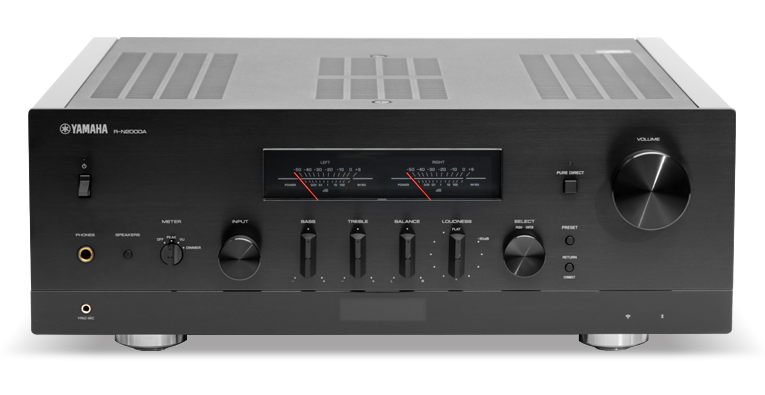
Until recently, the integrateds in Yamaha’s luxurious four-digit series all lacked internal DACs. That changed with the recent introduction of the R-N2000A, which is actually a receiver. Not only does the R-N2000A include an internal DAC, it has ethernet, Wi-Fi, and Bluetooth connectivity. And it incorporates Yamaha’s MusicCast streaming platform and the Yamaha Parametric room Acoustic Optimizer (YPAO) room-correction system. It also includes an FM tuner (the European and Australian variants having a DAB tuner), and all versions support internet radio, so the R-N2000A is technically a streaming receiver-DAC. Priced at $3999.95, the R-N2000A is a serious contender for anyone shopping for a high-quality component of this type.
The ultimate utility player
Initial supplies of the R-N2000A seemed tight, but thankfully Yamaha Canada was able to send me a black unit from the first shipment to arrive in the country. In addition to the usual power cord and battery-operated remote, included in the box are a microphone for YPAO room correction and an FM antenna. Once I had extracted everything from its packaging, I was struck by the R-N2000A’s beauty. The VU meters on its front panel aren’t as large as those gracing the A-S3200, but otherwise, it’s as gorgeous as its more expensive sibling, which I consider one of the most attractive integrated amplifiers currently available.
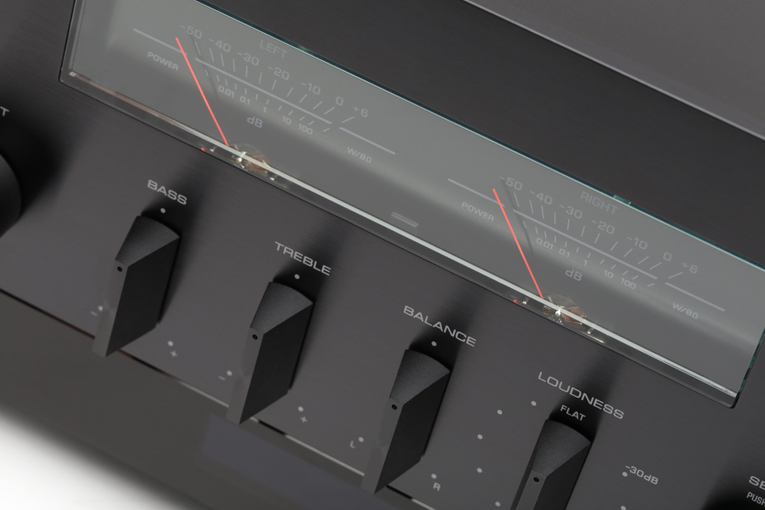
Along the bottom of its faceplate, the R-N2000A has a black strip where the OLED display is located; other Yamaha amplifiers do not have this strip. Because of this element and the smaller VU meters, I prefer the look of the black finish to the silver, which I thought looked fantastic on the A-S3200. Except for the OLED display and a few additional controls, the R-N2000A looks very similar to Yamaha’s attractive A-S2200 and A-S1200 integrated amplifiers.
The machined-aluminum controls on the brushed-aluminum front panel all have a very positive feel. There’s a power toggle on the left with an LED that lights up when the unit is turned on or glows dimly in standby mode. Below the power switch are a 6.5mm headphone jack and a 3.5mm jack for the YPAO microphone. A small pushbutton allows for selection of A or B speakers; the setting is shown on the OLED display. Next is a rotary dial for controlling the VU meters. You can set the meters for Peak or VU operation, turn them off, or dim them. Another larger dial allows you to cycle through the inputs; your selection is shown on the display. Additional dials are provided for Bass, Treble, Balance, and Loudness. During my listening sessions, I left these controls in their default settings. The tone controls can be defeated by the Pure Direct button; this setting also disables DSP functions and access to the menu system in addition to turning off the front-panel display and indicator light. The Select knob is used for navigating menus and selecting options. The Preset button is used for cycling through pre-programmed FM and internet radio stations, while the Return/Connect button is used for operating the menu system or connecting to a MusicCast network. Two small LEDs on the lower right show Wi-Fi and Bluetooth connection status. On the far right is a large volume control.
The front panel is well laid out and very attractive in a retro kind of way, and it’s nicely enhanced by the piano-black side panels. Additionally, the functioning of the OLED display is well thought out. Although a little small, the display is legible enough for menu navigation. During playback, it indicates the digital audio format (PCM or DSD), along with the sampling frequency. The display also indicates the current volume setting with a numerical value and an easy-to-read circular graphic—another nice touch.
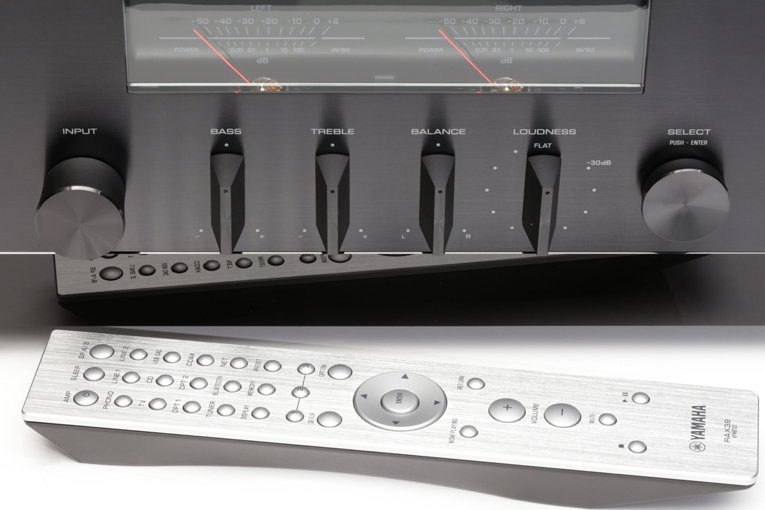
This attention to detail is carried through to the remote control, which is nicely weighted and has a solid feel. A group of small buttons on the upper half provides direct access to inputs. On the sparsely populated bottom half are two large buttons for turning the volume up and down, and at the bottom, three smaller buttons for mute, stop, and play/pause functions; all of them are easily distinguishable and readily accessible. I found the remote intuitively laid out and a pleasure to use, which isn’t something I can say about most remotes, including some for very high-end components.
The back panel is tidily laid out with analog RCA inputs for Line 1, Line 2, CD, and MM Phono, plus a ground terminal. There are also stereo preamp outputs and a single subwoofer output jack. On either side of the analog inputs and outputs are two pairs of extremely high-quality speaker binding posts cut from brass for speakers A and B. Along the top are two optical (TosLink) and one coaxial (RCA) S/PDIF inputs, a USB Type B port for connection to a computer, an ethernet port, and an HDMI ARC input for connection to a television, as well as two Micro-USB service ports. The back panel also contains a 12V trigger input, an FM antenna input, and a two-prong IEC power inlet.
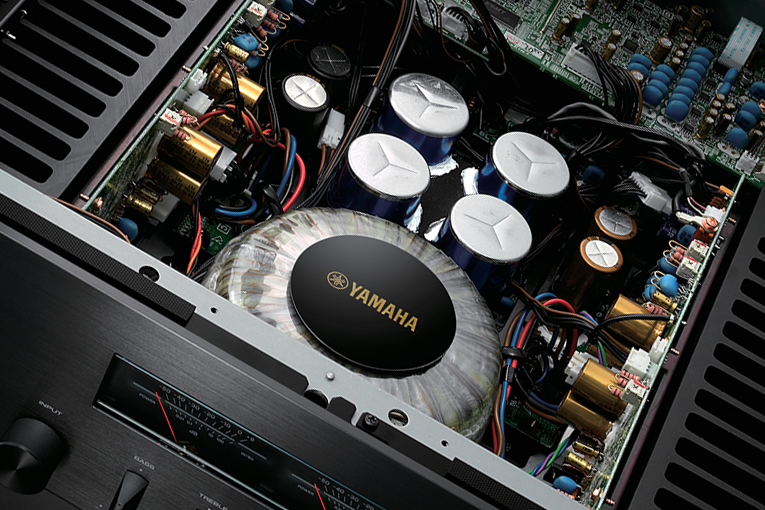
In addition to its outward beauty, the R-N2000A benefits from Yamaha’s excellent design and extremely high build quality. The large toroidal transformer and filter capacitors are visible through the top vents. The R-N2000A also features Yamaha’s Mechanical Ground Concept: the silver-plated brass feet, heat sinks, power transformer, and filter capacitors are bolted directly to the main chassis, for reduced vibration and increased rigidity. The Floating and Balanced circuit design is said to place output components with the same polarity on the plus and minus sides of the output stage, resulting in what Yamaha describes as symmetrical pull-pull operation. This improves signal-to-noise performance, according to Yamaha.
For the first implementation of a digital section in their four-digit series of amplifiers, Yamaha has gone all-out by incorporating an ESS Sabre ES9026PRO Ultra DAC chip, along with DSP for their proprietary YPAO room correction system. The MusicCast platform supports Amazon Alexa and Google Assistant voice control, along with Apple AirPlay 2, Spotify Connect, and Tidal Connect. Available for iOS and Android, the MusicCast app has integrated support for several streaming services, including Amazon Music, Deezer, Qobuz, and Tidal. The S/PDIF inputs can accept PCM streams up to 24-bit/192kHz. Via USB, ethernet, and Wi-Fi, the R-N2000A can accept PCM data up to 32/384 and DSD up to 11.2MHz (DSD256).
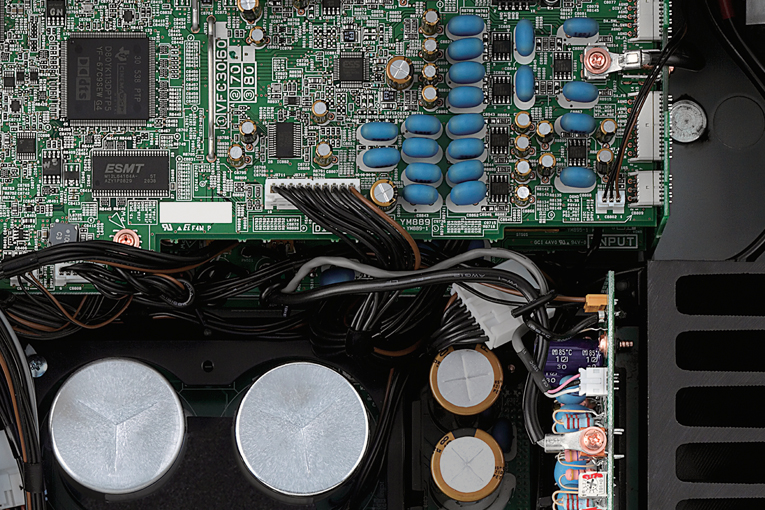
Rated power output is 90Wpc (20Hz–20kHz with 0.07% THD) into 8 ohms or 145Wpc into 4 ohms, with a damping factor of 250 or more. The headphone output is rated at 25mW into 32 ohms with 0.2% THD at 1kHz. With Pure Direct engaged, Yamaha claims a frequency response of 20Hz–20kHz, +0/-0.3dB, and 5Hz–100kHz, +0/-3dB; total harmonic distortion of 0.04% for phono to pre-out (1.0Vrms) and 0.035% for the line-level inputs (CD/LINE1/LINE2) to the speaker outputs (45W at 8 ohms); and S/N ratios (IHF-A Network) of 95dB for the phono input and 110dB for any of the line-level inputs.
The R-N2000A measures 17.1″W × 6.1″H × 18.6″D and weighs a very hefty 48.7 pounds. I can’t overemphasize how attractive I found this well-built, beautifully finished Yamaha receiver. While its amplification circuitry is not as massively built as the much more expensive A-S3200, and its smaller VU meters aren’t quite as sumptuous, the R-N2000A features a state-of-the-art digital input section with DSP and a full-featured streaming platform, along with an FM tuner—and it costs only half as much! As with most of Yamaha’s premium four-digit series components, the R-N2000A is warranted for a very respectable five years in the US and Canada.
The starting lineup
For most of my listening, I paired the R-N2000A with my MartinLogan ESL 9 hybrid electrostatic loudspeakers and an Intel NUC computer running Windows 10 and Roon. Besides streaming from Tidal, I played some locally stored FLAC and DSF files. I also used Tidal Connect when I moved the R-N2000A into my family-room system later in the review period, connecting it to a pair of Paradigm Monitor SE 8000F loudspeakers.

Initial setup took only a few minutes. Once I’d installed the MusicCast app on my Samsung Galaxy S21 smartphone, the app discovered my Wi-Fi LAN and updated the amplifier’s firmware. While I was completing these steps, progress bars and completion percentages were displayed both in the app and on the R-N2000A’s front-panel display—another thoughtful touch. I then set MusicCast to allow streaming services and selected Tidal Connect with the R-N2000A as the output device—and I was ready to go. I tested most of the other digital connection options and MusicCast. But as I mentioned, I did most of my listening from Roon using my Intel NUC, which I connected to the R-N2000’s USB port. You can read more about the MusicCast platform in Gordon Brockhouse’s review of the Yamaha WXA-50 MusicCast streaming amplifier ($599.95), but in my limited experience, I found it to be relatively easy to use and very stable.
I’ll describe the effect of YPAO room correction on both of my systems later in this review, but mention now that calibration was straightforward and quick. Plugging the microphone into its jack automatically initiated the calibration process. MusicCast can be used to adjust YPAO settings, such as distances to speakers (in 5cm increments from 30cm to 24m), subwoofer crossover frequency (in 20Hz increments from 40 to 80Hz, 10Hz increments from 80 to 120Hz, and 40Hz increments from 120 to 200Hz), and speaker levels (from -10 to +10dB in 0.5dB increments).
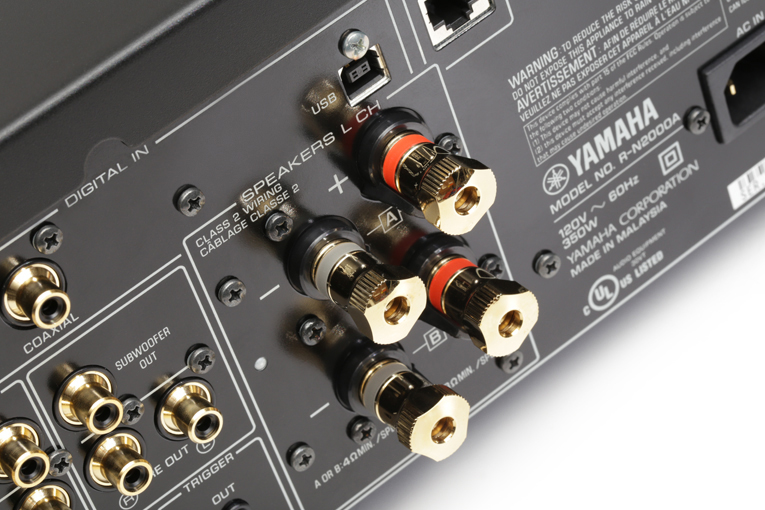
I used the R-N2000A’s menu system only to turn YPAO on or off, but found it quite easy to navigate using the remote. It can also be accessed via a combination of buttons on the front panel. Settings can be adjusted for the network connection, Bluetooth, YPAO, HDMI ARC, maximum and initial volume, display auto-standby and brightness, and sleep timer. An additional Option menu can be accessed via the remote to configure individual inputs for volume trim from -10dB to +10dB, displaying audio format and sampling frequency, linking volume control to devices connected via Bluetooth or AirPlay, and various tuner and playback modes.
Hitting for the cycle
As was my experience with the Yamaha A-S3200, the R-N2000A sounded a little lean right out of the box. So I ran it for a few weeks before doing any serious listening. I’m not a big believer in the need to break in components, but I found the Yamahas sounded noticeably better with somewhere between 50 and 100 hours of play on them. I began my critical listening with the R-N2000A driving MartinLogan ESL 9 loudspeakers in my main system.
Listening to Yellow Magic Orchestra’s eponymous 1978 album (DSD64 DSF, GT Music / Alfa) put me in a nostalgic mood as I watched the gently swaying VU meters on the front panel of this vintage-styled amplifier. From the opening deep melodic synth chords of “Tong Poo,” the richness and sense of weight were immediately reassuring. When Yukihiro Takahashi’s drums kicked in, the perfectly timed pace picked up with a thrilling solidity and agility. The R-N2000A certainly had no problem driving the hybrid-electrostatic ESL 9s.
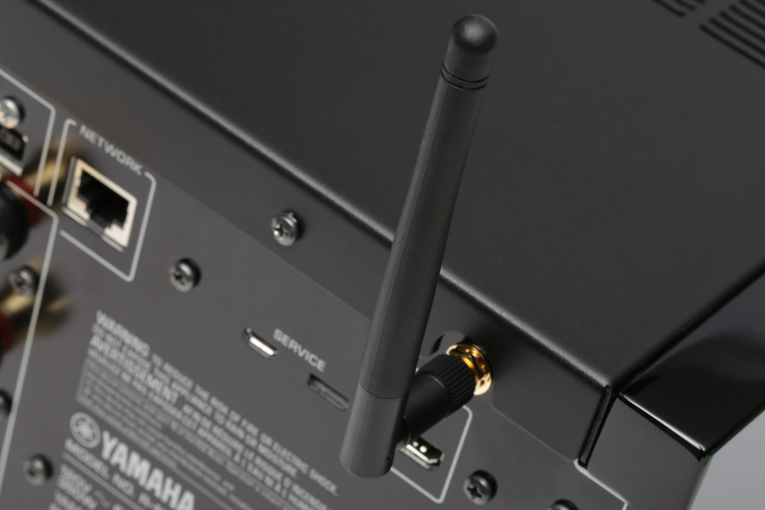
On the infectious “La Femme Chinoise,” the bouncy bass line remained dense and rubbery yet well-defined. Synth effects floated uncannily around the soundstage while the slightly husky female vocals remained solidly anchored dead center, immediately between the speakers. “Firecracker” sounded big and spacious, with the playful melody placed precisely in the middle, while the percussion was spread more evenly from speaker to speaker.
The R-N2000A handled YMO’s playful, pioneering electronica with a steady hand, but it also sounded wonderful when I played the more introspective “Merry Christmas Mr. Lawrence (Electric Youth Remodel)” from A Tribute to Ryuichi Sakamoto—To the Moon and Back (24/48 FLAC, Sony / Tidal). On this more recent recording, Sakamoto’s synth chords were smoother and more compactly textured, and beautifully integrated with the acoustic strings and piano. There was an exquisitely ethereal quality to the sound that allowed me to lose myself in the music, but I was also a little surprised by how well the Yamaha was able to reproduce the deep, solid drum beat that starts around the 1:50 mark.
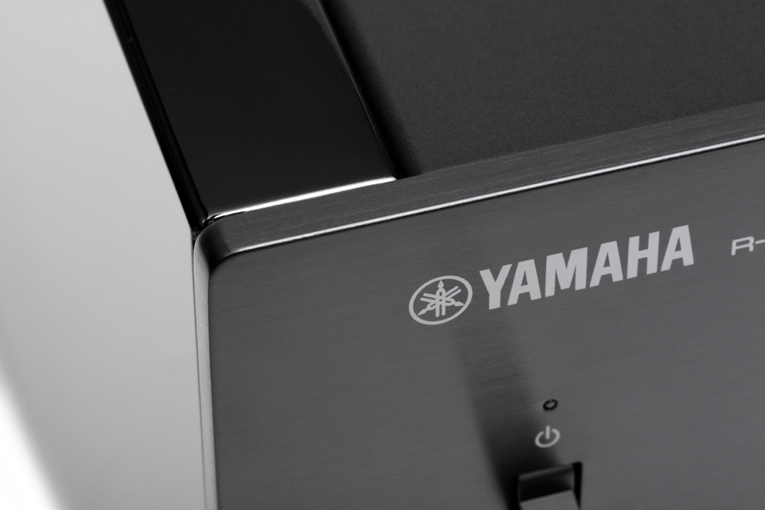
On the sparingly recorded version of “Merry Christmas Mr. Lawrence” from Playing the Piano 12122020 (16/44.1 FLAC, KAB America / Tidal), Sakamoto delivers an extremely intimate interpretation of the song on solo piano. There was so much presence and detail I could picture the nearly 70-year-old YMO alum gently caressing the keys to coax each note from the piano, imparting it with the years of experience he’d acquired since first recording this song nearly 40 years ago. The Yamaha amp conveyed all the emotion in the music, imparting just the slightest hint of warmth, thus removing any signs of sterility or leanness in the upper registers that sometimes characterize solo piano recordings.
The phono section of the R-N2000A was so quiet that the only noise I heard while playing AC/DC’s Back in Black (LP, Columbia 69699 80207 1) was the small amount of surface noise from my copy of the record. The Yamaha did full justice to this powerful, straight-ahead 1980s rock production. The Young brothers’ gloriously loud guitars came alive on “Hells Bells,” cutting and screeching through Brian Johnson’s super-clean vocals. Listening to this classic rock album through the Yamaha was an absolute blast.
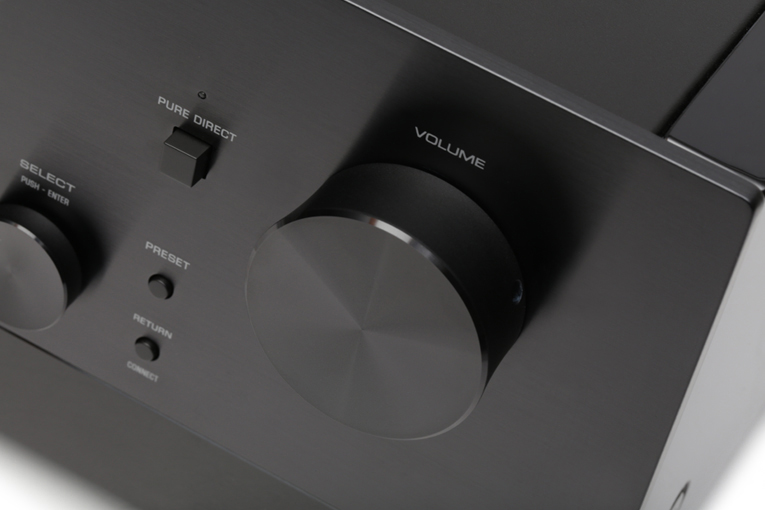
Having proven itself very capable of driving my MartinLogan ESL 9s, I moved the R-N2000A to my family-room system to see how it would perform with Paradigm’s more modest Monitor SE 8000F loudspeakers. Watching episodes of Lucifer on Netflix with the audio playing through the amplifier’s HDMI ARC interface, I was impressed by how well the dialog and sound effects tracked the onscreen action. The Yamaha amp made music from television soundtracks, such as the Tom Ellis / Debbie Gibson cover of “Every Breath You Take” from later episodes of Lucifer, sound like good stereo recordings. Its performance was comparable to my reference integrated amplifier-DAC, the Hegel H120.
Streaming “Love Shack [12″ Remix]” by the B-52’s from Time Capsule: The Mixes—Hallucinating Pluto (16/44.1 FLAC, Warner Records / Tidal) via Tidal Connect, the R-N2000A delivered deep rich bass and an exceptionally wide stereo image. However, when I switched back to the H120 with Tidal streamed via Roon, individual instruments and vocals became a little clearer and more forward, albeit with less warmth. This caused the soundstage to shrink just a bit. Through the Hegel amplifier, I was better able to experience the complex layered sound of “Break My Soul (The Queens Remix)” performed by Beyoncé and Madonna (24/44.1 FLAC, Columbia Records / Tidal). With the Paradigms, I marginally preferred the sound of the Hegel, although I did miss the slight warmth of the Yamaha.
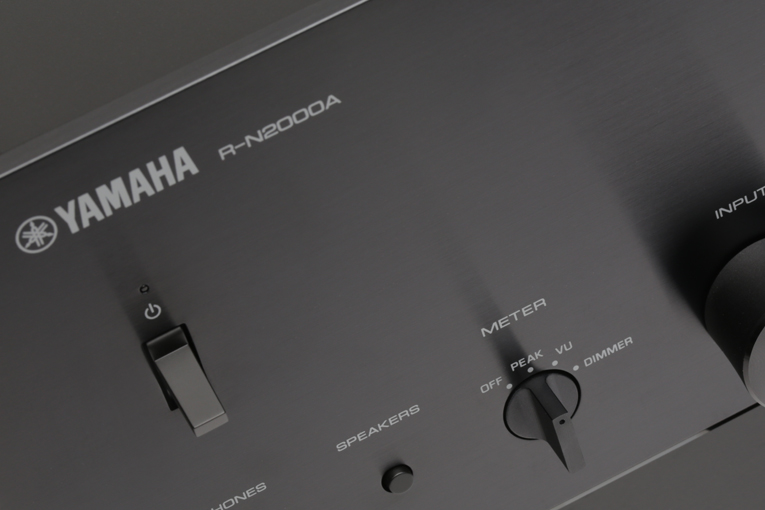
Now it was time to try out the R-N2000A’s YPAO room-correction processing. YPAO tightened the focus, although this had the effect of shrinking the soundstage to dimensions similar to that of the H120. The complex EDM rhythms of “Break My Soul (The Queens Remix)” were more discernible, but they were confined to a slightly smaller area between the speakers than before, and delivered with less depth. While there was a bit less bass, it was definitely more controlled, and the big Paradigms were still pumping out enough low frequencies to energize my entire room. With the less-than-ideal placement of my Paradigm speakers in the corner of my family room, the benefits of YPAO were obvious: enhanced clarity and imaging for a more realistic and three-dimensional presentation. With YPAO enabled, I preferred the R-N2000A over the H120 in my family-room system.
Next, I moved the Yamaha back into my main system to see how YPAO would affect its performance with the MartinLogan ESL 9s. In this larger, more symmetrically laid-out room, the benefits of YPAO weren’t as obvious. As before, it delivered increased clarity, with more precise imaging and improved bass definition. But the improvement wasn’t as dramatic as it had been in my smaller family room with its asymmetrical layout. With YPAO smoothing out the sound just a little too much, “White Wedding (Part 1)” from Billy Idol’s eponymous album (24/192 FLAC, Capitol / HDtracks) was now missing some of the dynamic highs and lows that contribute to the song’s driving energy. Adding my JL Audio E-Sub e112 powered subwoofers and using YPAO to adjust the crossovers helped a bit by allowing the music to play even louder and more clearly. But even this did not restore all of the dynamics to the sound of the R-N2000A in my larger room with ESL 9s. In this case, I preferred the sound of the R-N2000A without YPAO engaged.
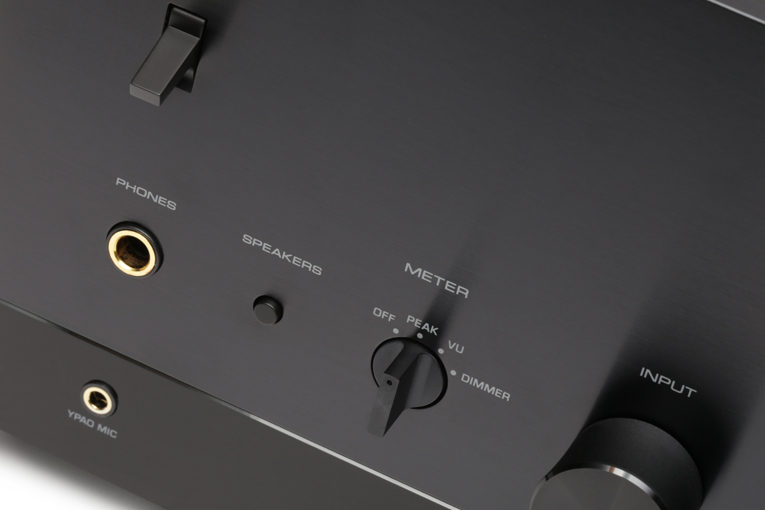
The headphone output of the R-N2000A was extremely impressive, outperforming the headphone outputs of my Hegel H120 amplifier and reference Oppo Digital UDP-205 4K UHD universal BD player. With the HiFiMan HE400se headphones, there was more precise imaging and air around the instruments, and the swirling sounds of Sting’s “Desert Rose” from My Songs (Deluxe) (24/44.1 FLAC, A&M / Interscope / Tidal) appeared all around me. Through the Hegel, the soundstage tended to collapse towards each earpiece and the space inside my head, and imaging was less precise. The bass was also more incisive and solid through the R-N2000A, with the drumbeats on “Love Shack [12″ Remix]” by the B-52’s starting and stopping with greater control.
A walk-off victory
There’s so much good stuff going on with the Yamaha R-N2000A that it’s difficult to sum up its virtues in just a few sentences. To put things into perspective, it wasn’t as accomplished-sounding as its far pricier all-analog sibling, the A-S3200. And in some ways, it was slightly bested by the Hegel H120, which has only basic connectivity. However, the R-N2000A has a fantastic, full-featured digital section that includes Yamaha’s proprietary YPAO room correction system and MusicCast streaming platform, in addition to many other features. Add to this its powerful and satisfying sound, ability to drive my ML ESL 9 loudspeakers with relative ease, stunning good looks, and rock-solid construction, and it’s not hard to understand why the R-N2000A is my new favorite reasonably priced integrated amplifier-DAC.
. . . Roger Kanno
rogerk@soundstagenetwork.com
Note: for the full suite of measurements from the SoundStage! Audio-Electronics Lab, click here.
Associated Equipment
- Speakers: MartinLogan Masterpiece Classic ESL 9, Paradigm Monitor SE 8000F.
- Subwoofers: JL Audio E‑Sub e112 (×2).
- Integrated amplifier-DAC: Hegel Music Systems H120.
- Turntable: Pro-Ject Audio Systems X1 with Ortofon Pick it S2 cartridge.
- Headphones: HiFiMan HE400se.
- Digital sources: Intel NUC computer running Windows 10, Roon, and Tidal; AudioQuest JitterBug jitter reducer; Oppo Digital UDP-205 4K UltraHD universal Blu-ray player.
- Speaker cables: Shunyata Venom-X, Clarus Aqua Mark II.
- USB link: AudioQuest Carbon.
- Power cords: Clarus Aqua, Essential Sound Products MusicCord-Pro ES.
- Power conditioners: Blue Circle Audio PLC Thingee FX‑2 with X0e low-frequency filter module, Zero Surge 1MOD15WI.
Yamaha R-N2000A Stereo Network Receiver
Price: $3999.95.
Warranty: Five years, parts and labor.
Yamaha Corporation of Japan
10-1, Nakazawacho
Naka-ku Hamamatsu-shi
Shizuoka 430-8650
Japan
Yamaha Corporation of America
6600 Orangethorpe Avenue
Buena Park, CA 90620
USA
Yamaha Canada Music Ltd.
135 Milner Avenue
Toronto, Ontario M1S 3R1
Canada
Website: usa.yamaha.com






















